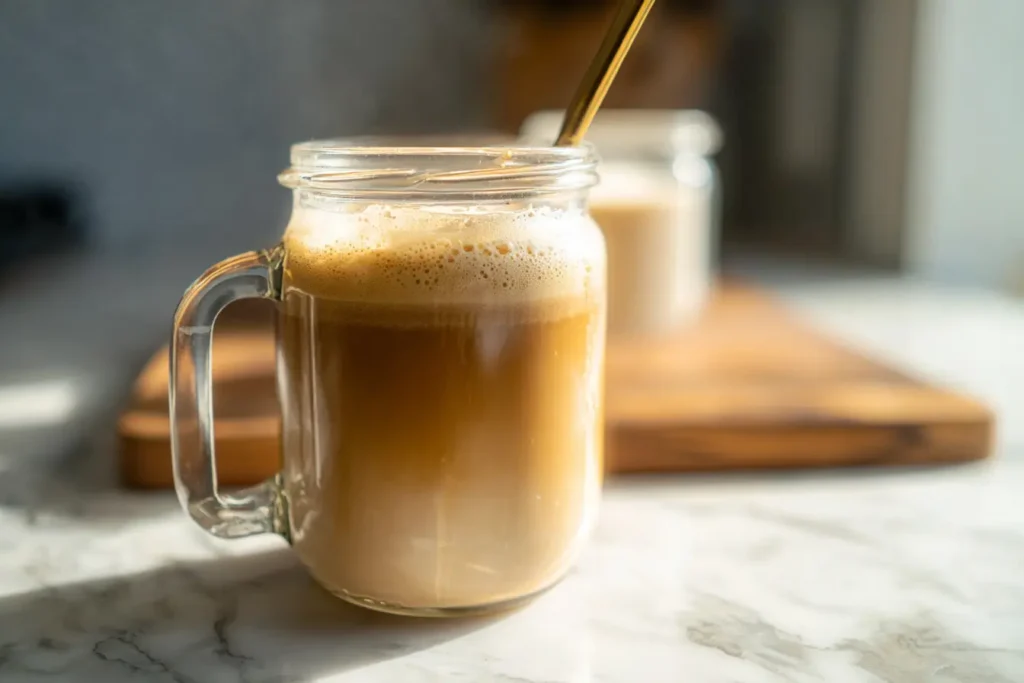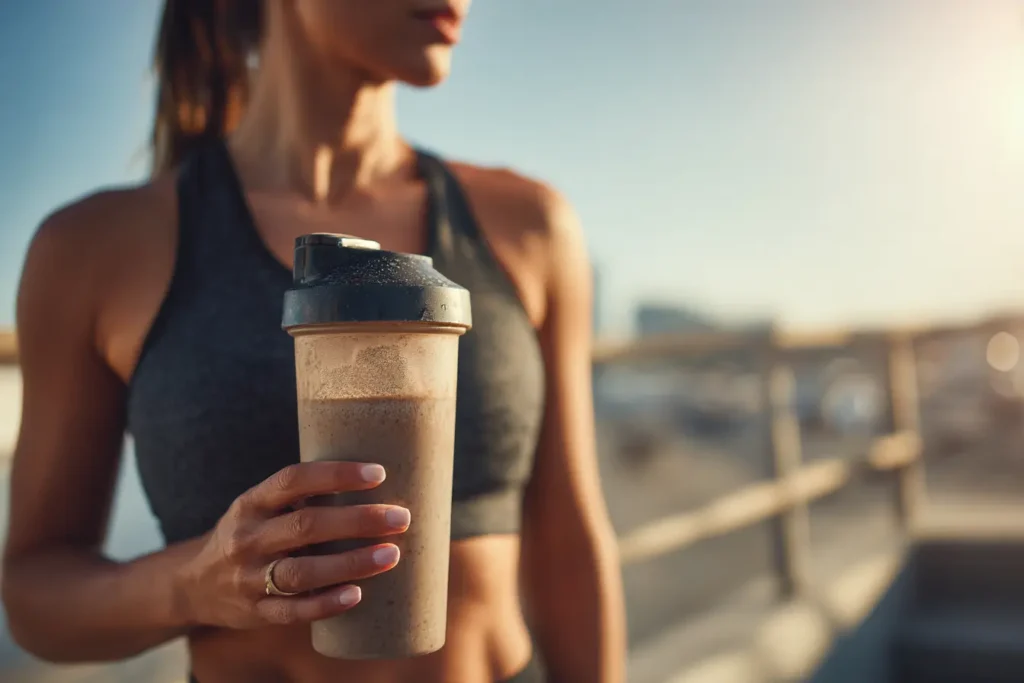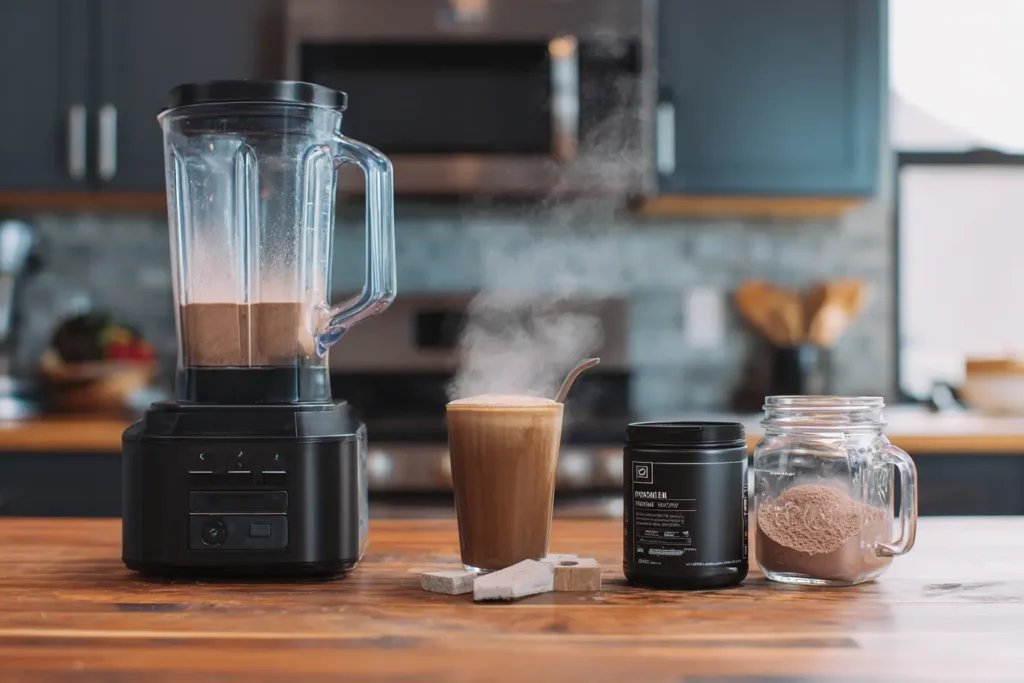If you’re trying to start your morning with something that’s both energizing and nourishing, this protein coffee recipe is your new go-to. More than just a trendy blend, it’s a powerful way to fuel your day with caffeine and protein in one smooth cup. Whether you’re into fitness, watching your macros, or simply want a satisfying drink that won’t leave you crashing, you’ll find what you need here.
In this guide, we’ll explore everything from how to make the best protein coffee recipe, to what kind of protein works best, to creative ways to customize your blend. We’ll also answer top questions like “Is protein coffee actually healthy?” and show you the science-backed benefits behind the drink.
Don’t miss our Pumpkin Seed Milk Recipe – The Best 2025 Guide to Creamy, Healthy Plant Milk for another great dairy-free addition to your protein coffee!
Let’s dive into why this combination of protein and caffeine might just be the smartest thing you add to your morning routine.
Table of content
Table of Contents

Introduction to Protein Coffee
What is protein coffee?
At its core, a protein coffee recipe blends brewed coffee with a dose of high-quality protein—usually in powder form. Think of it like a protein shake crossed with a rich cup of joe. It can be served hot or iced, depending on your preference, and tailored with flavors like vanilla, mocha, or cinnamon. The idea is to kickstart your morning or post-workout recovery with a drink that provides both alertness and muscle support.
This isn’t your average coffee. A good protein coffee recipe packs at least 15–25 grams of protein per serving while keeping added sugar to a minimum. That makes it a balanced choice for breakfast, a pre-workout boost, or even a midday snack.
Some people also use collagen protein or whey isolate in their recipes because of their fast absorption and neutral taste. Others prefer plant-based proteins like pea or soy, especially in vegan versions of the drink.
Why combine coffee and protein powder?
There’s more to this combo than just taste. Caffeine gives you mental clarity and a burst of energy, while protein helps reduce hunger and supports muscle repair. When you put them together in a protein coffee recipe, you get a drink that satisfies cravings, fuels your body, and keeps your metabolism humming.
Here’s why many fitness lovers and busy professionals swear by it:
- Protein reduces the blood sugar spike often caused by caffeine alone.
- You stay full longer compared to just drinking coffee.
- It’s portable and fast—no need to cook breakfast or prep a shake separately.
Additionally, blending protein with coffee may support weight management, especially when used as a meal replacement or to curb snacking.
Looking for inspiration? Try Baking Soda Trick for Men Recipe – The Best 2025 Natural Health Hack if you’re experimenting with new wellness drink trends.
By the end of this article, you’ll know exactly how to choose ingredients, avoid clumps, and turn a basic cup of coffee into your favorite health drink. Ready for the next level? Let’s move on to the benefits of drinking a protein coffee recipe daily.
Health Benefits of Protein Coffee

Energy and satiety in one cup
When you start your day with a protein coffee recipe, you’re doing more than waking up—you’re fueling up. One of the biggest benefits of this unique combo is how it provides both instant energy and long-lasting fullness. The caffeine from coffee gives you that quick mental boost, while the protein keeps hunger at bay for hours.
Unlike a regular latte or black coffee that might leave you reaching for a muffin an hour later, a high-protein coffee drink can help stabilize your blood sugar levels and prevent crashes. This makes it perfect for early risers, busy professionals, or anyone following a low-carb or intermittent fasting lifestyle.
Studies show that pairing caffeine with protein leads to improved focus, alertness, and appetite control—a triple win. In fact, this kind of drink is becoming popular among people on keto, paleo, and even vegan meal plans thanks to its nutrient-dense profile.
Muscle recovery and metabolism boost
Another powerful reason to make a protein coffee recipe part of your routine is its effect on muscle recovery. After a workout, your body needs protein to repair and rebuild. Add caffeine into the mix, and you enhance post-exercise muscle glycogen resynthesis, according to research.
Drinking a protein coffee recipe after training or strength workouts helps speed up muscle healing and supports lean muscle growth, especially when using whey or collagen protein. It’s no wonder athletes are swapping traditional shakes for coffee-based alternatives.
In addition, the combination of thermogenic caffeine and protein slightly boosts your resting metabolic rate, which can aid with fat loss over time. Your body uses more energy to digest protein (the “thermic effect”), and caffeine enhances calorie burn for a few hours post-consumption.
So, in one simple drink, you’re not only recovering smarter—you’re also encouraging your body to burn more calories naturally.
Check out Pitaya Bowl: The Best 2025 Superfruit Smoothie for Energy & Weight Loss if you’re looking for a powerful post-workout snack to pair with your coffee!
By combining convenience, nutrition, and performance benefits, the humble protein coffee recipe becomes far more than a trend—it’s a strategic health move.
Best Protein Powders for Coffee
Whey vs. plant-based protein in coffee
Choosing the right protein for your protein coffee recipe is where things get exciting—and sometimes tricky. The two most popular choices are whey protein and plant-based protein, each with its own pros and cons when mixed with coffee.
Whey protein, especially whey isolate, is one of the top picks because of its smooth texture, fast absorption, and mild taste. It dissolves better than many other types and is low in carbs, which is ideal if you’re watching your macros or doing keto.
On the flip side, plant-based protein powders like pea, soy, or rice protein are perfect for vegans or anyone sensitive to dairy. They tend to be higher in fiber and more alkaline, which some people find easier on the stomach. However, some plant proteins may create a slightly chalky texture unless blended well.
So, which one should you choose for your protein coffee recipe? Here’s a quick comparison table to help you decide:
| Protein Type | Ideal For | Pros | Cons |
|---|---|---|---|
| Whey Isolate | Fitness, weight loss | Smooth texture, fast-digesting | Not vegan, dairy-based |
| Pea Protein | Vegan, gut-sensitive | Plant-based, allergen-friendly | Slightly gritty texture |
| Collagen Peptides | Beauty & joint health | Heat-stable, dissolves easily | Low in complete amino acids |
| Soy Protein | Muscle building (vegan) | Complete protein, affordable | May contain phytoestrogens |
Flavor, solubility, and heat resistance comparison
Not all proteins are created equal when it comes to hot coffee. The wrong choice can lead to clumping, curdling, or an unpleasant taste. That’s why the best protein for your protein coffee recipe should have heat resistance, good solubility, and a neutral or complementary flavor.
Here’s what to look for:
- Heat-resistant proteins: Collagen peptides and whey isolate handle hot coffee without separating or clumping.
- Flavor compatibility: Vanilla, mocha, or unflavored proteins work best in coffee. Avoid fruit-flavored or overly sweet options.
- Smooth texture: Look for fine powders with no added gums or fillers for better mixability.
Pro tip: If your protein clumps in coffee, use a blender or milk frother instead of stirring. Or try mixing your protein with a bit of room-temperature liquid first before adding hot coffee.
Discover great ideas like Avocolada Tropical Smoothie Recipe – The Best Creamy Island Blend (2025) for another protein-packed beverage that blends smoothly.
In the end, the best protein powder for your protein coffee recipe depends on your goals and dietary needs. Want creamy and rich? Try whey. Need something plant-powered? Go with pea or soy. Looking for skin and joint benefits too? Collagen is your go-to.
How to Make the Perfect Hot Protein Coffee


Protein Coffee Recipe – The Best 2025 Energy Drink
- Total Time: 2 minutes
- Yield: 1 serving
Description
Protein coffee recipe for energy and weight loss. Try this easy, low-calorie drink for focus and fat burn.
Ingredients
- 1 cup brewed coffee (hot or cold)
- 1 scoop protein powder (whey, collagen, or plant-based)
- 1/2 cup almond milk (optional)
- Sweetener, cinnamon, or cocoa to taste
- Ice cubes (for iced version)
Instructions
Brew your coffee and allow to cool slightly.
Add protein powder and milk to blender.
Pour in coffee and blend until smooth.
For iced version, pour over ice and serve chilled.
- Prep Time: 2 minutes
- Cook Time: 0 minutes
- Category: High Protein Meals
- Cuisine: American, Fitness, Keto
Step-by-step classic hot protein coffee recipe
Making the ideal protein coffee recipe at home is simple, but the process matters—especially when you’re working with hot liquids and powders that can clump. Whether you’re a beginner or just looking to refine your technique, here’s a foolproof method for hot, frothy protein coffee.
Ingredients:
- 1 cup freshly brewed hot coffee (not boiling)
- 1 scoop of protein powder (whey, collagen, or plant-based)
- Optional: 1/4 cup unsweetened almond milk or oat milk
- Optional: cinnamon, stevia, or vanilla extract
Instructions:
- Brew your favorite coffee and let it cool slightly for 2–3 minutes. (This helps prevent the protein from curdling.)
- Add your protein powder to a blender or shaker cup first.
- Slowly pour in the warm (not boiling) coffee.
- Add milk or sweetener if desired.
- Blend for 15–30 seconds until smooth and frothy.
- Pour into your favorite mug and enjoy!
Using this method ensures your protein coffee recipe turns out smooth and enjoyable every time. It also allows you to control the flavor, texture, and sweetness—making it easy to tailor it to your preferences or dietary needs.
If you want even more expert advice and variations, check out this full guide on how to make protein coffee at home by The Big Man’s World: Protein Coffee Recipe – How To Make It
Tips to avoid clumping and curdling
One of the biggest turn-offs when trying a protein coffee recipe is when it turns gritty, clumpy, or curdled. But don’t worry—these common mistakes are totally avoidable with the right tricks.
Top tips:
- Avoid adding protein to boiling liquid. Let your coffee cool for a minute or two first.
- Use a milk frother or blender. Stirring isn’t enough to fully dissolve the protein.
- Try collagen peptides if you’re looking for a guaranteed smooth blend with no clumps.
- Pre-mix with room-temp water before adding to coffee. This helps proteins dissolve better in heat.
Don’t miss our Acai Smoothie Recipe – The Best 2025 Vegan Antioxidant Blend if you love powerful breakfast drinks that support wellness and recovery.
By following these tips and the recipe above, you’ll master the art of making hot protein coffee recipes that rival anything from a coffee shop—but with twice the nutrition and none of the sugar overload.
Iced Protein Coffee Recipe Variations

High-protein iced latte recipe
If hot drinks aren’t your thing—or it’s 90 degrees outside—an iced protein coffee recipe can deliver the same nutritional benefits with a cool, creamy twist. It’s a fantastic way to sneak in protein while staying hydrated and refreshed.
Here’s a quick iced protein latte version to get you started:
Ingredients:
- 1 cup chilled brewed coffee or cold brew
- 1 scoop vanilla or chocolate protein powder
- 1/2 cup unsweetened almond milk or oat milk
- Ice cubes
- Optional: dash of cinnamon, stevia, or sugar-free syrup
Instructions:
- Add chilled coffee, protein powder, and milk to a shaker bottle or blender.
- Shake or blend for 30 seconds until smooth.
- Fill a glass with ice and pour over your protein mix.
- Top with cinnamon or cocoa powder if desired.
This iced protein coffee recipe is perfect post-workout or mid-afternoon when you need a clean energy kick without turning to sugary drinks or heavy snacks.
Discover great ideas like Tropical Smoothie Cafe Avocolada Recipe – The Best 2025 Creamy Smoothie to add more protein-packed sips to your menu.
Cold brew + protein: A summer favorite
Cold brew coffee pairs especially well with protein powders due to its lower acidity and naturally smooth flavor. Many people love mixing collagen or whey isolate into cold brew for a grab-and-go protein drink with no chalky aftertaste.
Here’s how to make a simple cold brew protein coffee recipe:
- Mix 1 cup of cold brew with 1 scoop of unflavored or mocha protein.
- Blend well (don’t stir—it’ll clump).
- Add a splash of cashew milk for creaminess.
- Serve over ice in a mason jar for that café aesthetic.
Cold brew tips:
- Brew it overnight in the fridge using coarsely ground coffee and a French press.
- Store the concentrate for up to 5 days and mix fresh servings with protein as needed.
Looking for inspiration? Try Lemon Balm for Weight Loss – The Best 2025 Natural Slimming Trick as a side wellness drink for your summer mornings.
With these variations, your protein coffee recipe doesn’t have to be boring or repetitive. You can enjoy it year-round, iced or hot, flavored or classic—all while sticking to your fitness goals.
Customizing Your Protein Coffee
Adding flavor: Cinnamon, vanilla, cocoa
One of the best parts about creating your own protein coffee recipe is how customizable it is. You’re not limited to plain or boring shakes—there are endless ways to infuse flavor, texture, and sweetness based on your taste or health goals.
Try any of these natural, flavor-packed add-ins:
- Cinnamon: Adds warmth and helps balance blood sugar.
- Vanilla extract: Perfect for smoothing out the bitterness of strong coffee.
- Unsweetened cocoa powder: For a mocha-style protein coffee.
- Maple extract or caramel stevia: A zero-calorie way to mimic sweet treats.
- Nutmeg or cardamom: Add a chai-like twist to your drink.
These spices and extracts can transform your basic protein coffee recipe into a gourmet-style drink without extra sugar or calories.
For those avoiding sugar, opt for natural sweeteners like monk fruit, stevia, or erythritol. You can even blend in a frozen banana for a creamy, naturally sweet version—great for post-workout recovery.
Don’t miss our What Is the Bariatric Seed Recipe? The Best Natural Weight Loss Mix if you’re into low-cal, high-benefit health boosters.
Choosing your milk: Dairy vs. non-dairy
Your choice of milk can totally change the feel and nutrition of your protein coffee recipe. Whether you prefer full-fat creaminess or plant-based lightness, there’s an option for everyone.
Best dairy options:
- Skim or 2% milk: Good protein source, budget-friendly.
- Half & half or heavy cream: Great for keto or low-carb versions.
- Fairlife ultra-filtered milk: High-protein and lactose-free.
Top non-dairy choices:
- Almond milk: Low in calories, subtly nutty.
- Oat milk: Creamy and blends well, but higher in carbs.
- Cashew milk: Rich and smooth, great for lattes.
- Coconut milk: Adds tropical flavor and healthy fats.
Most people on plant-based diets opt for almond or oat milk in their protein coffee recipe, while keto followers go for heavy cream or MCT oil for that bulletproof-style upgrade.
If texture is important to you, always use a blender or handheld frother to mix everything together. This gives your drink a coffeehouse-style froth and avoids gritty lumps from protein powder.
Whether you like it classic, mocha-flavored, or totally plant-based, customizing your protein coffee recipe ensures it never gets boring—and always works with your diet.
Common Mistakes When Making Protein Coffee
Protein separation in hot liquids
One of the biggest issues people run into when trying a protein coffee recipe for the first time is protein separation. That’s when the powder doesn’t mix properly and instead floats on top or forms gritty bits at the bottom of your cup.
This usually happens when the coffee is too hot or the protein isn’t heat-stable. Here’s how to avoid it:
- Let your coffee cool slightly before adding protein. Ideal temperature: 140–150°F.
- Use a blender or frother instead of stirring with a spoon.
- Choose the right protein powder, like collagen or whey isolate, both of which mix better in hot liquids.
Another overlooked trick? Mix your protein with a few tablespoons of room-temperature water or milk before pouring in your coffee. This creates a slurry that prevents clumping or separation.
Remember, your protein coffee recipe should be smooth, creamy, and easy to drink—not a science experiment gone wrong.
Choosing the wrong coffee or protein type
The type of coffee you use can drastically change your experience. A highly acidic or bitter roast might not pair well with flavored or plant-based protein powders, leading to an unpleasant aftertaste. Similarly, using cheap protein powders with fillers and artificial flavors can ruin the taste or texture of your drink.
Here’s what to watch out for:
- Avoid flavored coffee if your protein is already sweetened—it’s flavor overload.
- Don’t use casein or egg white protein in hot drinks—they clump fast.
- Stay away from soy protein if you’re concerned about hormonal effects or allergies.
Learn more about Baking Soda Trick for Men Recipe – The Best 2025 Natural Health Hack for simple upgrades to your wellness drinks.
And don’t forget about portion control. Adding too much protein can overpower the coffee taste, while too little won’t give you the health benefits you’re aiming for. Stick with 15–25g protein per serving to keep your protein coffee recipe balanced.
Small tweaks go a long way when it comes to perfecting your drink. Avoid these pitfalls and you’ll enjoy a reliable, satisfying cup every time.
Is Protein Coffee Actually Healthy?
Nutritional analysis (calories, macros)
At first glance, a protein coffee recipe might sound like a fitness gimmick—but when done right, it’s surprisingly balanced. It offers a blend of protein, caffeine, and optional healthy fats, without the sugar spikes of a flavored latte or energy drink.
Here’s a sample breakdown of a basic protein coffee recipe:
| Ingredient | Amount | Calories | Protein | Fat | Carbs |
|---|---|---|---|---|---|
| Black coffee (8 oz) | 1 cup | 2 | 0g | 0g | 0g |
| Whey isolate (1 scoop) | 25g | 100 | 20g | 1g | 2g |
| Unsweetened almond milk | 1/2 cup | 15 | 0.5g | 1g | 1g |
| Total (no sweetener added) | — | 117 | 20.5g | 2g | 3g |
That’s a low-calorie, high-protein drink with no added sugar—and it can be made dairy-free, low-carb, or even keto with just a few tweaks. For many people, this makes it a smart alternative to sugary coffeehouse drinks that run upwards of 300+ calories and are low in nutrients.
It also fits well into:
- Intermittent fasting protocols
- Low-carb or keto diets
- Post-workout recovery windows
- Meal replacement strategies for weight loss
Check out Pitaya Bowl: The Best 2025 Superfruit Smoothie for Energy & Weight Loss for another great low-cal, nutrient-dense breakfast idea.
When to drink it: Breakfast, post-workout, or snack?
Timing matters. The best moment to enjoy your protein coffee recipe really depends on your lifestyle and goals. Here are a few options that work for most people:
- Morning (breakfast replacement): Combine caffeine and protein to keep you full and alert through mid-morning. Add healthy fats like MCT oil if following keto.
- Pre-workout: About 30–60 minutes before exercise, it delivers an energy boost and primes your body for recovery.
- Post-workout: Ideal if you’re skipping the shake—your body needs protein for muscle repair, and coffee can enhance glycogen restoration.
- Afternoon snack: Beats the 3 PM crash. A protein coffee recipe curbs cravings while keeping you productive without a sugar high.
Is it healthy? Absolutely—if you use clean ingredients and keep the add-ins minimal. Avoid pre-made mixes loaded with artificial flavors, gums, or sugar alcohols. Always read labels and experiment until you find the blend that feels right for your energy, digestion, and flavor preferences.
So yes, your protein coffee recipe isn’t just healthy—it can be one of the smartest, most versatile tools in your wellness routine.
Protein Coffee for Weight Loss and Fitness
Using protein coffee in intermittent fasting
One of the most effective ways to use a protein coffee recipe for weight loss is by incorporating it into an intermittent fasting plan. Many people follow methods like 16:8 or OMAD (One Meal a Day), where eating is restricted to a specific window each day.
Here’s how your protein coffee recipe can help:
- Keeps you full longer: The protein suppresses ghrelin, your hunger hormone, helping you extend your fast.
- Minimal insulin response: If you use clean protein (like collagen or whey isolate) with black coffee, it may not fully break your fast, depending on your goals.
- Prevents overeating later: Starting with a protein-focused drink can reduce cravings and calorie intake throughout the day.
It also makes fasting easier for beginners, who struggle with hunger and energy crashes in the morning. While traditional coffee offers energy, the addition of protein adds nutritional depth and satiety.
Best times to drink it for fat-burning results
Timing is everything when using a protein coffee recipe to enhance fat burning and muscle retention. Depending on your routine, these windows offer the best results:
- Morning (fasted state): Great for jumpstarting metabolism and reducing hunger.
- Pre-workout (30–60 min before): Delivers both energy from caffeine and amino acids from protein to fuel performance.
- Post-workout (within 45 min): Supports muscle recovery, replenishes glycogen, and prevents catabolism.
- Mid-afternoon: Combats the “snack attack” and keeps blood sugar stable until dinner.
If you’re on a cutting phase, doing HIIT, or just trying to drop a few pounds, consistency with your protein coffee recipe is key. Swap it for sugary lattes or carb-heavy snacks and track your progress over a few weeks.
Looking for inspiration? Try Tropical Smoothie Cafe Avocolada Recipe – The Best 2025 Creamy Smoothie for another post-workout, fat-burning option.
The beauty of the protein coffee recipe lies in its adaptability. Whether you’re tracking macros, managing cravings, or training hard at the gym, it supports both fat loss and muscle gain—without sacrificing flavor or convenience.
FAQs About Protein Coffee Recipe
Can I mix my protein into my coffee?
Yes, you can mix protein powder into your coffee, but how you do it matters. If you’re using hot coffee, allow it to cool slightly before blending in your protein to avoid clumping. Using a blender or milk frother is highly recommended to create a smooth texture. This method ensures your protein coffee recipe is enjoyable and consistent every time.
What is the best protein powder to add to your coffee?
The best protein powders for coffee are those that are heat-stable and low in sugar. Whey isolate, collagen peptides, and plant-based options like pea protein work well. Look for options that are unflavored or come in coffee-friendly flavors like vanilla, mocha, or caramel. These blend smoothly and won’t overpower the taste of your brew—making for a perfect protein coffee recipe.
How to make hot protein coffee?
To make a hot protein coffee recipe:
Brew fresh coffee and let it cool slightly.
Add 1 scoop of protein powder (like whey or collagen) to a blender.
Slowly pour in the coffee and blend for 30 seconds.
Add sweetener or milk if desired, then serve.
This method gives you a smooth, frothy finish with no clumps—ideal for mornings or post-workout recovery.
Is protein coffee actually healthy?
Absolutely! A clean protein coffee recipe made with quality ingredients is packed with benefits: it supports muscle repair, stabilizes blood sugar, curbs appetite, and increases alertness. It’s also low in calories and high in protein, making it a perfect addition to weight loss, intermittent fasting, or fitness-focused routines.
Conclusion
The protein coffee recipe isn’t just a health trend—it’s a practical, powerful way to energize your body and support your fitness goals. Whether you prefer it hot or iced, plant-based or whey-powered, the flexibility and benefits of protein coffee make it a game-changer in your daily routine.
You’ve learned how to:
- Pick the right protein powder for taste and solubility
- Avoid clumping and texture issues
- Customize your drink with spices, sweeteners, and milk options
- Use it effectively for weight loss, energy, and workout recovery
With so many ways to make it your own, this versatile drink can fit into any lifestyle. All you need is coffee, clean protein, and a few smart techniques—and you’ll never go back to plain old lattes again.
Discover great ideas like Pitaya Bowl: The Best 2025 Superfruit Smoothie for Energy & Weight Loss to expand your collection of healthy, high-protein breakfasts.
